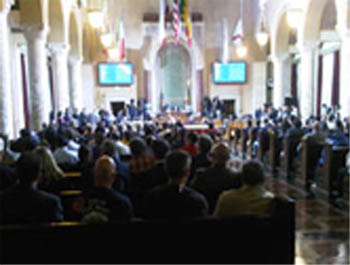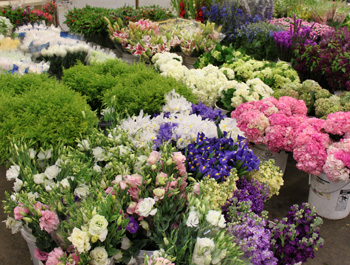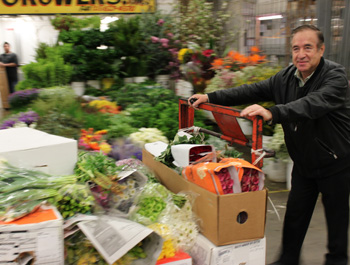Listen to an audio story from Annenberg Radio News:
—–
The Los Angeles City Council voted Tuesday to approve plans for a massive redevelopment of the Wilshire Grand Hotel. After two years of planning, a 13-1 vote approved plans for a groundbreaking development in downtown Los Angeles. The estimated $1.2 billion project will include a 45-story reconstruction of the Wilshire Grand Hotel with an accompanying 65-story office building.
 “I’m really amazed at how anyone could be opposed to this,” Councilman Dennis Zine said. “How anyone in their right mind would be opposed to this project that’s going to bring jobs, economy and help downtown Los Angeles.”
“I’m really amazed at how anyone could be opposed to this,” Councilman Dennis Zine said. “How anyone in their right mind would be opposed to this project that’s going to bring jobs, economy and help downtown Los Angeles.”
The agreement is between the city and two private companies, Thomas Properties and Korean Air. Council member Jan Perry says the project will bring in $22 million a year for the city’s general fund in 2015. Developers say it will bring in more than 7,000 construction jobs and 6,000 permanent jobs. The head of the Los Angeles County Federation of Labor, Maria Elena Durazo, is in full support.
“We ask you to not only support it, but to hold it up as an example that we want all employers and all developers to follow,” Durazo said.
The city council’s plans were met with some skepticism. Digital signage and LED lighting would cover the two huge buildings from top to bottom. Barbara Broide of the Coalition to Ban Billboard Blight said the signs could create a safety hazard to motorists on the 110 Freeway.
“You have abdicated your responsibility to protect our safety from these signs that are designed to catch the attention of all who pass,” Broide said.
The vast majority of the audience in city hall, however, was excited about the redevelopment.
“I just spoke to Santa Claus and the Easter Bunny and they both support this project,” said Kevin Norton, member of the International Brotherhood of Electrical Workers.
The existing Wilshire Grand Hotel is set to be demolished in December as part of the approved agreement.









 The large electric sign that rose above Clune’s Broadway once read “The Time, the Place.”
The large electric sign that rose above Clune’s Broadway once read “The Time, the Place.” For that reason, both the City of Los Angeles and the Los Angeles Conservancy passed initiatives to “bring back Broadway.”
For that reason, both the City of Los Angeles and the Los Angeles Conservancy passed initiatives to “bring back Broadway.” While the City of Los Angeles has focused its efforts on making the district appealing to investors, the Los Angeles Conservancy has worked to promote the restoration of its 12 theatres.
While the City of Los Angeles has focused its efforts on making the district appealing to investors, the Los Angeles Conservancy has worked to promote the restoration of its 12 theatres. The Broadway initiative also drafted construction guidelines for the historic buildings in the Theatre District.
The Broadway initiative also drafted construction guidelines for the historic buildings in the Theatre District. On the Sunday after Thanksgiving, the temperatures downtown dipped into low 40′s. In Pershing Square, Angelinos glided around a skating rink which is ringed by trees decorated with Christmas lights. Nearby, a small line of L.A.’s down-and-out population formed up for a free dinner. The smell of greens and beans was in the air along with holiday music as a band of volunteers dished out the food. The volunteers brought with them large vats of food, along with hot sauce, plates and water, but one thing they didn’t bring with them is bombs.
On the Sunday after Thanksgiving, the temperatures downtown dipped into low 40′s. In Pershing Square, Angelinos glided around a skating rink which is ringed by trees decorated with Christmas lights. Nearby, a small line of L.A.’s down-and-out population formed up for a free dinner. The smell of greens and beans was in the air along with holiday music as a band of volunteers dished out the food. The volunteers brought with them large vats of food, along with hot sauce, plates and water, but one thing they didn’t bring with them is bombs. Some chapters actually do end up serving meat which is not encouraged because of health and food safety reasons. Aaron Linas, another volunteer, added that some chapters are more overtly political than others. He said some chapters will bring literature when they hand out food, but the L.A. chapter is not as political as those ones.
Some chapters actually do end up serving meat which is not encouraged because of health and food safety reasons. Aaron Linas, another volunteer, added that some chapters are more overtly political than others. He said some chapters will bring literature when they hand out food, but the L.A. chapter is not as political as those ones.


 A little after midnight, a shipment of baby’s breath arrived at the Los Angeles Flower Market.
A little after midnight, a shipment of baby’s breath arrived at the Los Angeles Flower Market. Mayesh Whole Florists Inc. specializes in high-end flowers, which Dahlson aptly described as “stuff grown in different parts of the world.”
Mayesh Whole Florists Inc. specializes in high-end flowers, which Dahlson aptly described as “stuff grown in different parts of the world.” Dahlson pointed out his niece, as she bustled around the stand collecting flowers. She is a designer for Mayesh Wholesale Florists Inc., a third generation wholesale flower vendor.
Dahlson pointed out his niece, as she bustled around the stand collecting flowers. She is a designer for Mayesh Wholesale Florists Inc., a third generation wholesale flower vendor.




